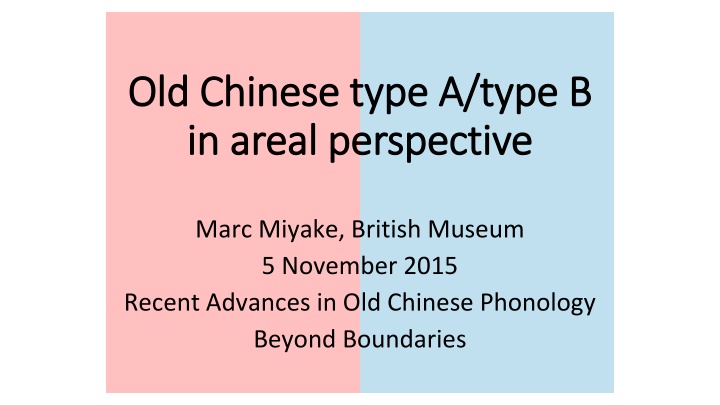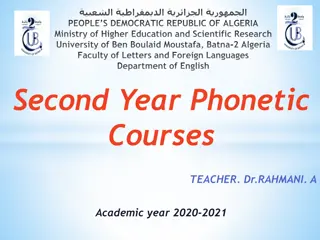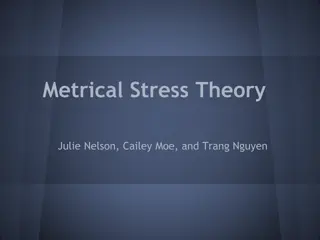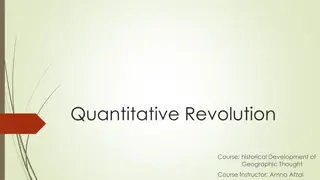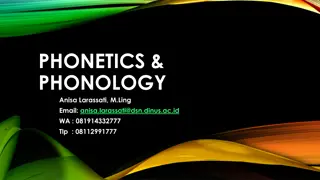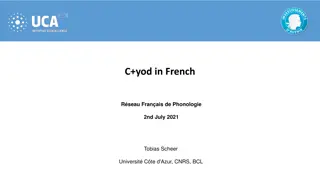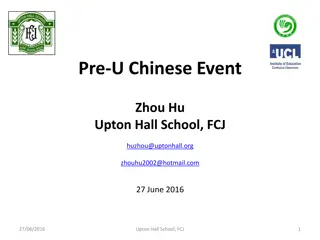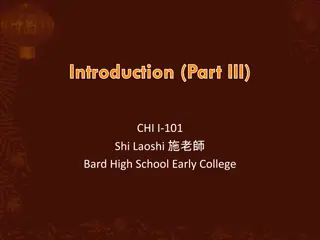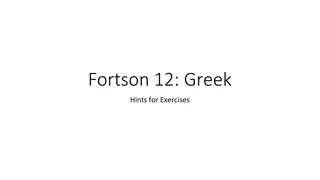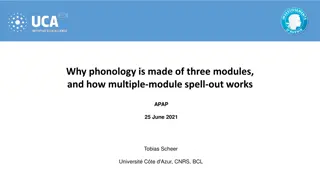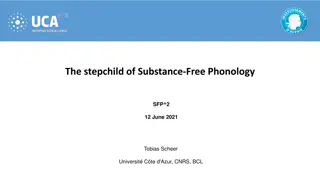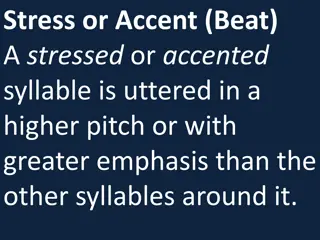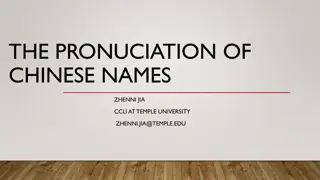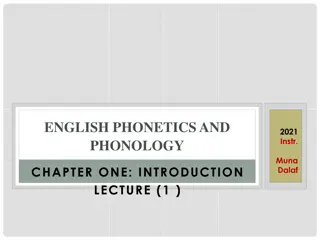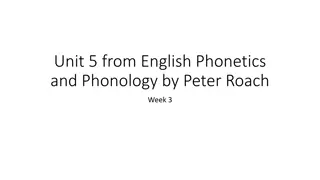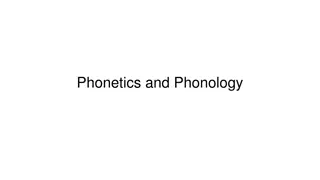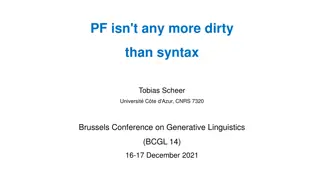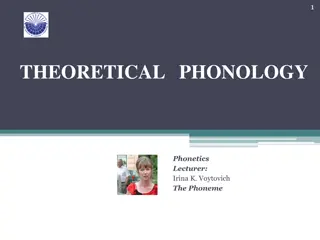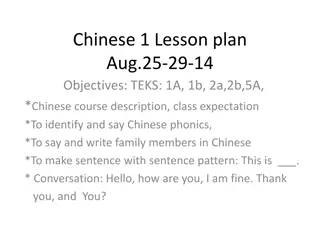Recent Advances in Old Chinese Phonology: Areal Perspectives and Syllabic Types
Explore the evolution of Old Chinese phonology through an areal perspective, focusing on the classification of syllabic types into Type A and Type B with further interpretations by linguistic scholars like Karlgren, Pulleyblank, and Norman.
Download Presentation

Please find below an Image/Link to download the presentation.
The content on the website is provided AS IS for your information and personal use only. It may not be sold, licensed, or shared on other websites without obtaining consent from the author.If you encounter any issues during the download, it is possible that the publisher has removed the file from their server.
You are allowed to download the files provided on this website for personal or commercial use, subject to the condition that they are used lawfully. All files are the property of their respective owners.
The content on the website is provided AS IS for your information and personal use only. It may not be sold, licensed, or shared on other websites without obtaining consent from the author.
E N D
Presentation Transcript
Old Chinese type A/type B Old Chinese type A/type B in areal perspective in areal perspective Marc Miyake, British Museum 5 November 2015 Recent Advances in Old Chinese Phonology Beyond Boundaries
Part 1: The Maltese key The background is a modification of a file by Alecastorina93 licensed under the Creative Commons Attribution-Share Alike 3.0 Unported license.
The Karlgrenian consensus The Karlgrenian consensus Old Chinese had two kinds of syllables Type A: without *-j- *ka Type B: with *-j- *kja
The Pulleyblank revolution ( The Pulleyblank revolution (1962 Old Chinese had two kinds of syllables Type A: short vowels *ka 1962) ) Type B: long vowels *kaa
Other interpretations of types Other interpretations of types A A and and B B Jaxontov (1965): absence vs. presence of voiced prefix Type A ka vs. type B *d-ka Pulleyblank (1973): accent on second vs. first mora Type A k vs. type B *k Zhengzhang (1987) & Starostin (1989): long vs. short vowel Type A kaa vs. type B *ka Reverse of Pulleyblank (1962)! Ferlus (reported in Sagart 1999): complex vs. simple initial Type A *C.ka vs. type B *ka
Norman Norman s emphatic theory ( s emphatic theory (1994 Old Chinese had three kinds of syllables Type A: pharyngealized consonants *k a 1994) ) Type B: plain consonants *ka
Did you notice I wrote three three and not two two ? I left out Norman s third type of syllable: retroflex. Norman called retroflex syllables type B and plain syllables type C: A *k a : B *kra : C *ka pharyngealized : retroflex : plain
Is the retroflex category really necessary? Is the retroflex category really necessary? Norman s type B *kra corresponds to type A and B syllables in other systems. *kra A vs. *kra B Type A and B syllables with *-r- undergo special developments that I won t go into here.
My other problems with My other problems with Norman ( Norman (1994 1994) in ) in 1995 1995 Norman wrote, all Early [i.e., Old] Chinese syllables developed a palatal medial (or yod) [i.e., *-j-] along with a palatalized initial and generally a more palatal vowel, unless this process was somehow impeded ... by a pharyngealized consonant: *ka > *kja but He drew parallels with Arabic. Arabic!? Without a specific example. What good could these parallels be if almost all that palatalization never occurred (as Pulleyblank had been arguing for years)? *k a > *ka
Years of uncertainty Years of uncertainty I was almost entirely agnostic about the type A/B distinction. But at least I was certain that it did not involve *-j-. I was not convinced by either version of the vowel length hypothesis. They conflicted with Chinese transcriptions of Indic languages with vowel length. They conflicted with Sinospheric phonological typology. (I know of no Sinitic-type language which has a short vs. long vowel distinction in nonreduced open syllables.) But apart from those two caveats, I had no idea.
The Schuessler shakeup The Schuessler shakeup In 2000, Wolfgang Behr gave me a copy of Axel Schuessler s unpublished manuscript on Later Han Chinese (which I will call Late Old Chinese). Until then I was accustomed to the complex vowel changes of Starostin s Late Old Chinese reconstruction. So complex I wrote a list for myself to try to keep track of them. But I instantly understood Schuessler s vowel changes!
Schuessler Schuessler s vowel bending s vowel bending So simple I instantly memorized it (What follows is my further simplification.) Before Late Old Chinese: just six vowels high series: *i * *u vs. low series *e *a *o
Type A syllables Type A syllables: high series vowels bend into closing diphthongs *i > *ei * > * *u > *ou Low series vowels *e *a *o stay low.
Type B syllables Type B syllables: low series vowels bend into opening diphthongs *e > *ie *a > * a *o > *uo High series vowels *i * *u stay high.
Older northern vs. newer southern bending Older northern vs. newer southern bending Khmer: Schuessler-type Late Old Chinese Type A = *voiceless, type B = *voiced Type A *ki > k j Type A *ki > *kei Type A *ku > *kou Type A *ku > kou Type B *ka > *k a (> Middle Chinese *k ) Type B *ga > ki
What What bent high series type A vowels down: e.g., *i > *ei? bent low series type B vowels up: e.g., *o > *uo?
The Maltese moment The Maltese moment Maltese type A : high vowels bent down: Maltese type B : low vowel bent up silent g < pharyngeal * , uvular * kit b > ktieb book b b > bieb door cf. Old Chinese *a > * a * i > g i [e j] ~ [a j] cf. Old Chinese *i > *ei (> *ai) Norman mentioned the im la phenomenon in Arabic. At last I saw what it looked like! * i > g u [o w] ~ [a w] cf. Old Chinese *u > *ou (> *au)
None of that should have surprised me, because Arabic im la means bending !
So type A type A was characterized by pharygealization pharygealization ( emphasis But was it always that way? emphasis ).
Part 2: Through the bieb types A and B in areal perspective
Norman Norman 1994 1994 (emphasis mine) (emphasis mine) Some kind of division of words into two series, one of which is characterized by palatalization and the other by velarization or pharyngealization is a common phenomenon all over the Eurasian continent
Baxter and Sagart Baxter and Sagart s s typologically unusual typologically unusual system of system of 36 36 type A (emphatic) consonants type A (emphatic) consonants *p - *p -, *b -, *m -, *m - *t - *t -, *d -, *n -, *n - ts - *ts -, *dz -, *s - *l - *l -, *r -, *r - *k - *k -, *g -, *n -, *n - *k - *k -, *g -, *n -, *n - *q - *q -, * - *q - *q -, * - * -, * - All have type B (nonemphatic) counterparts except for the rare * -. I do not know of any language with more emphatics than nonemphatics. But I do know of languages with similarly structured consonant inventories.
Cairene Arabic (Youssef Cairene Arabic (Youssef 2006 2006) ) 23 emphatic (type A) consonants including some not in Baxter and Sagart s Old Chinese: [f v w z x (sic!) h ] Is there a real phonetic distinction between nonemphatic / nonpharyngealized pharygeals (sic!) [ ] and emphatic / pharyngealized pharyngeals (sic!) [h ]? Near-total symmetry like Baxter and Sagart s Old Chinese All emphatic consonants have nonemphatic counterparts The only nonemphatic consonant without an emphatic counterpart is [q] (which behaves like an emphatic consonant before [ ] BUT most emphatics are allophones of nonemphatics, not phonemes Only /t d s z r / are phonemes
Russian Russian Near-total symmetry of nonpalatalized (Norman: pharyngealized; type A) and palatalized ( type B) consonants like Baxter and Sagart s Old Chinese Most pairs are phonemes (unlike Cairene Arabic but like Baxter and Sagart s Old Chinese) BUT the Russian distinction involves palatalization and the Old Chinese distinction generally does not Some type B syllables palatalized in Late Old Chinese, but certainly not most
A A bit bit closer in time and space to Old Chinese: closer in time and space to Old Chinese: Old Turkic ( Old Turkic (8 8th th c. AD) c. AD) The runic script for Old Turkic has two series of consonants, one for back vowels ( type A) and another for front vowels ( type B): e.g., back ? <q> vs. front ? <k> The phonetic opposition may have been closer to that of Russian rather than Old Chinese though Russian doesn t have /q/ or even [q] or even /k/ vs. /k / The two series are nearly symmetrical There are some neutral consonant characters: e.g., ? <m> BUT there is no phonemic opposition between the two series
Cairene Arabic, Russian, Cairene Arabic, Russian, and Old Turkic and Old Turkic demonstrate that a large demonstrate that a large paired consonant system paired consonant system like Baxter and Sagart like Baxter and Sagart s is possible possible s is
However, in all three cases, a large system derives However, in all three cases, a large system derives diachronically or synchronically from a system with fewer diachronically or synchronically from a system with fewer or even no pairs or even no pairs Only 5 of the 23 Cairene emphatic consonants are phonemic; only 7 emphatic (here, ejective) consonants can be reconstructed for Proto-Afroasiatic (*p *t *tl *s *c *k *k ) (Ehret 1995) Although palatalization is currently phonemic in Russian, it was once predictable in early Slavic until short front vowels conditioning it were lost Backness/frontness of Old Turkic consonants can be predicted: no pairs like /qa/ vs. /ka/ (unlike Baxter and Sagart s Old Chinese)
Is the Old Chinese Is the Old Chinese consonant system also consonant system also derived from an earlier derived from an earlier system with fewer or system with fewer or even no pairs? even no pairs?
Was the Was the 36 short short- -lived stage that was too large to last? lived stage that was too large to last? 36- -emphatic system of Old Chinese a emphatic system of Old Chinese a My three-stage hypothesis: 1. Early Old Chinese: Few or no emphatics; emphasis predictable on the basis of factor X. 2. Middle Old Chinese: Factor X is partly or wholly gone, so emphasis is no longer predictable and is now phonemic. Bent vowel allophones develop after consonants. 3. Late Old Chinese: Emphasis in consonants is partly or wholly gone, so bent vowel allophones are no longer predictable and are now phonemic.
What was What was factor X factor X? ? There is an undeniable trend toward reduction in the region Baxter and Sagart s Old Chinese is sequisyllabic: *C .C(r)V(C)( /s) with only one possible vowel (* ) in presyllables before main syllables Modern Chinese is monosyllabic Chinese-style reduction can also be found in Kra- Dai, Hmong-Mien, Vietic, and even Chamic
What was What was factor X factor X? ? Given that the locus of emphasis was the initial consonant of the main syllable, factor X must have been close to the initial consonant
What was What was factor X What if emphatics are traces of lost vocalic distinctions in presyllables which are right before initials? factor X? ?
Emphatics Emphatics as a step in the as a step in the progression between progression between disyllables and disyllables and monosyllables monosyllables
Early Old Chinese Early Old Chinese Full first syllables of disyllables reduced to presyllables with only two possible vowels low vowels condition type A *Ce, *Ca, *Co > *C +emphasis high vowels condition type B *Ci, *C , *Cu > *C
Middle Old Chinese Middle Old Chinese Presyllabic vowels neutralized to schwa or lost entirely *C > *(C( ))-C V *C - > *(C( ))-CV
Why did Why did low low vowels condition vowels condition emphasis emphasis? ? Pulleyblank (1997) and Operstein (2010) regarded low [ ] as the syllabic form of a pharyngeal glide Low [ ] and [a] are syllabic allophones of pharyngeal / / in Salish (Bessell 1992) Low / / conditions pharyngeal allophones of consonants in Cairene Arabic (Youssef 2014)
Low Low vowel vowel- -conditioned conditioned emphatic emphatic spreading spreading mostly in accordance with mostly in accordance with areal trends areal trends
Low Low/ /high high vowel systems vowel systems Tungusic Koreanic (late and secondary) Much of Mongolic Khitan? Nivkh (Gruzdeva 1998: 11) Chukotko-Kamchatkan (Bobaljik 2009)
Harmony Harmony Arabic (emphasis spreading) Uralic (but palatal!) Altaic (Tungusic and Koreanic low/high, but Turkic palatal and Mongolic transitional) Nivkh (traces of low/high) Chukotko-Kamchatkan (low/high) Yukaghir (but palatal!; Maslova 2003: 35) Lhasa Tibetan (low/high) Ronghong Qiang (palatal/labial/rhotic; LaPolla & Huang 1996: 35-36)
What about original monosyllables? What about original monosyllables? 1. Early Old Chinese: Emphasis absent; later allophonic Low vowels: */Ce Ca Co/ Later *[C e C a C o] High vowels: */Ci C Cu/ 2. Middle Old Chinese: Emphasis phonemic Low vowels: */C e C a C o/ cf. Khalkha pharyngealized low series High vowels: */Ci C Cu/ 3. Late Old Chinese: Emphasis lost Low vowels: */Ce Ca Co/ High vowels: */Ci C Cu/
Emphatic harmony in disyllables like emphatic Emphatic harmony in disyllables like emphatic harmony in sesquisyllables on a larger scale harmony in sesquisyllables on a larger scale Type AA words: *g a l ep butterfly Type BB words: *g r n qilin
Emphatic harmony in disyllables like emphatic Emphatic harmony in disyllables like emphatic harmony in sesquisyllables on a larger scale harmony in sesquisyllables on a larger scale Harmony in reduplication: AA: *g res g ros carefree BB: *srit srut cricket See Miyake 2008 for statistics
Disyllables without emphatic Disyllables without emphatic harmony harmony Type AB and BA words less common opaque compounds and/or loanwords? e.g., *N-pr m-s a fabulous bird < wind sovereign with affixes?
Some problems for my Some problems for my extended extended emphatic emphatic theory theory
Some problems for my Some problems for my extended extended emphatic emphatic theory theory Why do my reconstructed low vowels sometimes correspond to high vowels of potentially related forms in Austronesian: e.g., my Early Old Chinese *C nu : Proto-Austronesian *punuq brain ? Ad hoc solution: an earlier form of this inherited?/ areal? word was *ponuq; *o lowered in Chinese but raised in Proto- Austronesian (which had no *o)?
Some problems for my Some problems for my extended extended emphatic emphatic theory Determining original vowels (if any) of prefixes *Ce- *Ca- *Co-? *Ci- *C - *Cu-? theory
Some problems for my Some problems for my extended extended emphatic emphatic theory Explaining type A/B doublets: e.g., *m-p e ~ *pe femur from *m-pe and *m -pe with variants of a body part prefix *m -? theory
Extending my Extending my emphatic theory extended extended emphatic Did Tangut also have a type A/B distinction, and if it did, did it originate in the same way? theory ? ?
